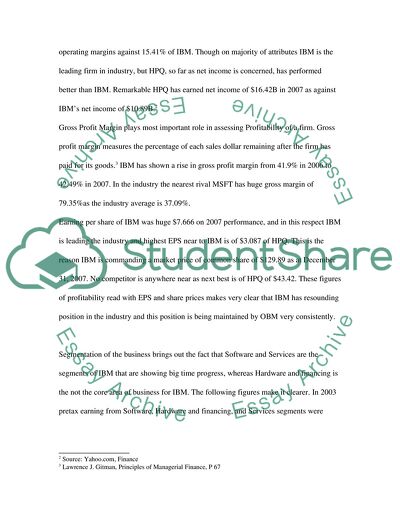
- Home
- Free Samples
- Premium Essays
- Editing Services
- Extra Tools
- Essay Writing Help
- About Us
- Studentshare
- Subjects
- Miscellaneous
- IBM financial and business indicators analysis
IBM financial and business indicators analysis - Essay Example

- Subject: Miscellaneous
- Type: Essay
- Level: Ph.D.
- Pages: 4 (1000 words)
- Downloads: 0
- Author: jacobsdee
Extract of sample "IBM financial and business indicators analysis"
These are Sales and Distribution organization, Research Development and Intellectual Property, and its Integrated Operations. In the first instance IBM’s geographic units align industry skilled resources to serve local customers’ agendas. IBM annually spends approximately $6 billion for R &D, focusing its investment in high growth, high value opportunities.1 The demand of computer systems, software, and services from around the world is the key driver of the company and that is why its products have performed consistently well both in strong and weak economic environments.
The main competitors of IBM in the industry are Electronic Data Systems Corporation (EDS), Hewlett- Packard Co.(HPQ), and Microsoft Corporation ( MSFT). Revenue wise only HPQ is somewhat near to IBM and profitability wise MSFT has 36.77% of operating margins against 15.41% of IBM. Though on majority of attributes IBM is the leading firm in industry, but HPQ, so far as net income is concerned, has performed better than IBM. Remarkable HPQ has earned net income of $16.42B in 2007 as against IBM’s net income of $10.89B.2 Gross Profit Margin plays most important role in assessing Profitability of a firm.
Gross profit margin measures the percentage of each sales dollar remaining after the firm has paid for its goods.3 IBM has shown a rise in gross profit margin from 41.9% in 2006 to 42.49% in 2007. In the industry the nearest rival MSFT has huge gross margin of 79.35%as the industry average is 37.09%. Earning per share of IBM was huge $7.666 on 2007 performance, and in this respect IBM is leading the industry and highest EPS near to IBM is of $3.087 of HPQ. This is the reason IBM is commanding a market price of common share of $129.
89 as at December 31, 2007. No competitor is anywhere near as next best is of HPQ of $43.42. These figures of profitability read with EPS and share prices makes very clear that IBM has resounding position in the industry and this position is
...Download file to see next pages Read More
- TERMS & CONDITIONS
- PRIVACY POLICY
- COOKIES POLICY